This study aims to suggest the guide line for weight category sports(Taekwondo, Judo, Wrestling, Weightlifting, and Boxing) who have to lose weight to pass weigh-in before games. Reference data was collected from RISS, Medline, PubMed, SciELO and effects of short term weight loss on physiological variables(body composition, physical fitness, blood components, oxidative stress and hormone, immune function) were analyzed. Also, weight loss procedures for weight category sports athletes were analyzed in details. The results of the research are as follows: weight category sports athletes prefer short term (3~5 days) weight loss methods (3~5%) with dietary control, sweating and exercise. Physical changes caused by the loss in body weight, fat-free mass, and BMI, however, do not affect body fat percentage. Different changes of physical strength element depend on weight reduction period. In short term weight loss method, anaerobic exercise capacity, muscular strength, and reaction time partially decrease and affect staying power. In contrast, long term weight loss method do not affect aerobic and anaerobic exercise capacity. Furthermore, most of previous studies show that blood component change has negative effect on body water balance, stress-related hormone, and immune function. In conclusion, short term weight loss method negatively affects athletic performance of weight class competition athletic. Therefore, careful long term weight loss methods are recommended with dietetic consideration to prevent dehydration during weight loss period. Excessive weight loss on lightweight athlete should be prevented by institutional basis as well.
This study was designed to examine the effects of 12 weeks of resistance exercise training on physique, body composition, insulin resistance, and blood lipid profiles in 20s normal weight obese females. Sixteen females were randomized into one of following two groups: resistance training group (RT group; n=8) and control group (CON group; n=8). Subjects in RT group completed 12 weeks of resistance exercise training for three times/wk, and subjects in CON group were asked to maintain their normal life pattern during the same intervention period. Data were analyzed using two-way repeated measures ANOVA with post hoc test. Main results of the present study were as follows: 1) Body weight, BMI, waist circumference, hip circumference, WHR, and WHtR decreased significantly in RT group. 2) All variables regarding body composition did not change in both groups; however, fat mass was tended to decrease more in RT group than CON group. 3) Fasting plasma glucose decreased significantly in both groups, whereas other variables regarding insulin resistance did not change significantly in both groups. 4) All variables regarding blood lipids did not change significantly in both groups. Results indicate that 12 weeks of resistance exercise training was beneficial in physique and body composition; however, it was not beneficial in insulin resistance and blood lipid profiles in 20s normal weight obese females. Future research including normal weight obese subjects with higher age would be warranted to elucidate more clearly the effects of resistance exercise training on metabolic status.

Sportscasting in Physical Education (Lee, 2011) is a class activity that students simulate sports broadcasting (e.g., students report, analyze, and comment on game play). It encourages problem solving (PS) learning for students. Scaffolding is the support with the intention of helping the student achieves his/her learning goals and contributes to problem solving. However, limited studies have examined if sportscasting with scaffolding is effective instructional strategies for PS. The purpose of this study was to examine effects of sportscasting with scaffolding on PS abilities, and on academic achievement. Participants were 46 college students. The static-group comparison design was used: an experiment group (N=26) with supportive scaffoldings (e.g., conceptual explanation, terminology dictionary, visual materials) and a control group (N=20) with reflective scaffoldings (e.g., organizing the environment, using appropriate cues to guide behaviors, and modeling). The results revealed that students in reflective scaffoldings had higher PS abilities than students in supportive scaffoldings. However, two groups were not statistically different in academic achievement. Sportscasting with instructional scaffolding promote a deeper level of cognitive skills and male students performed better than female students. The effective scaffolding types (Lewis, 2010) for sportscasting were discussed to help students to foster PS skills.

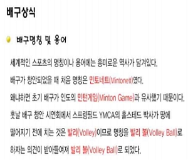
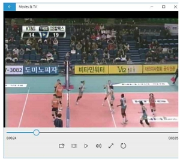
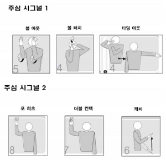
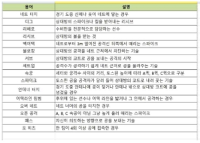
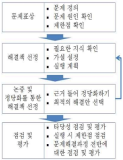
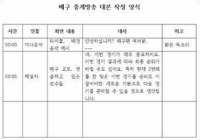
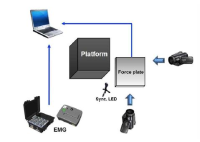
The purpose of this study was to investigate effects of carbon nanotube-based insole on the resultant joint moment and muscle activity of the lower extremity during drop landing. Ten males with no known musculoskeltal disorders were recruited as the subjects. Two digital camcorders and one force plate were used to obtain 3-D kinematics and kinetics of the lower extremity. To assess the myoelectric activities of selected muscles, five surface electrodes were attached to the right side of the lower extremity. For each dependent variable, paired t-test was performed to test if significant difference existed between with carbon nanotube-based insole(CNT) and ethylene vinyl acetate-based insole(EVA) conditions(p<.05). The results showed that average and peak IEMG values from RF, TA, MG, and LG in CNT were lower than corresponding values in EVA. Although no significant difference in resultant joint moment was found between two conditions, a decrease in the knee extension moment was found with CNT. This indicates that wearing carbon nanotube-based insole may help to decrease impact force and to control excessive flexion movement of the knee joint during landing.

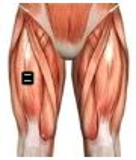
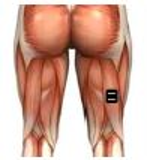
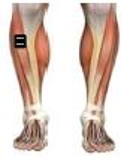
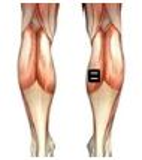

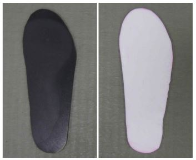
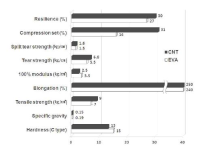
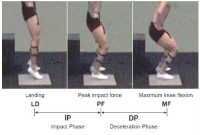

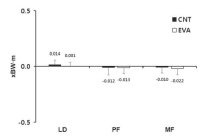
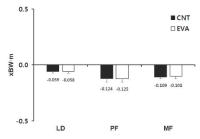

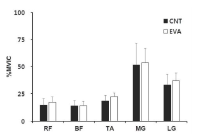

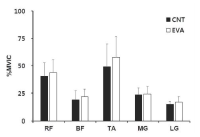
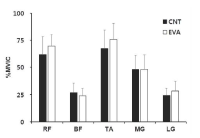
The purpose of this study was to examine psychological capital acquisition through Asian Games Participation. 17 of national women football players were completed Psychological Capitals Questionnair. The psychological capital consists of optimism, psychological skills, self-management, collective efficacy, and performance perception was investigated after the team call-ups and before the team-release. The data was analyzed by paired t-test. As results, Korean women football players’ collective efficient and performance perception showed a statistical significance at the beginning of the team call-ups but optimism, psychological skills, and self-direction did not show statistic significances. The team-harmony, interpersonal-management, team-power, sufficient training, trust in coach, efficient communication, and psychological football factors, which were subfactor of football players’ psychological capital, showed statistical significances. However, confidence, concentration, goal-setting, imagery, willpower, anxiety-control, mental-management, life-management, training-management, innate-behavior management, physical-management, football skills, mediative skills, and football intelligence factors did not have statistic significances. These results demonstrate that effects of mega sporting events-like experiences and psychological factors’ variability and inflexibility according to weather changes should be considered when it comes to discussion of psychological factors regarding players’ performance. It is expected that this study would be a fundamental resource for understanding of psychological influences through participations in mega sporting events and discussions about further psychological interventions for teams with environmental consideration as well as methodological developments which could measure effects of the psychological interventions.
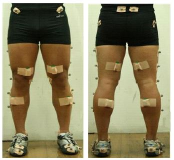
The purpose of this research is to investigate the factors affecting the performance capability of lunge movements by performing lunge movements which are commonly used as a method of instant physical movement in sports with a kinetic analysis including an EMG analysis. This research targeted 14 skilled fencers and made the subjects perform kick-lunges which allow them to go farthest from their positions and performed an analysis on such, applying a 3D motion analysis system and an EMG system. The subjects performed kick-lunges in two movements; one with a preliminary movement and the other without it and those are performed with both dominant leg and non-dominant leg. The result of this research is as follows. The lunges with a preliminary movement showed higher performance capability than those without it. Furthermore, as the level of skills gets higher, the length of lunges gets longer, and it seemed that a tactical mechanism shortening exercise performance times was used as a mechanism to control the impulse coming from such lengthened lunges. In addition, a difference appeared in mechanical factors such as moment and power in a dominant leg movement and it seemed to result from a difference in an functional capability using muscles.


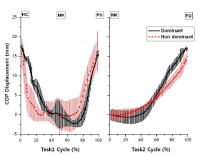



The main purpose of this study was to investigate the effects of treadmill exercise and bright light exposure on serotonin expression in rat brain. Male Sprague-Dawley (SD) rats were randomly assigned into four groups (n=9 in each group), specifically, control group (CG), exercise group (EG), light group (LG), and exercise+light group (ELG). Rats in EG were subjected to treadmill exercise (5 days/week, 30 min/day), LG rats exposed (5 days/week, 30 min/day, 10,000 Lux), ELG rats subjected to treadmill exercise in combination with exposure, and CG rats remained sedentary over a four-week period. We observed a significant increase in serotonin expression in the raphe obscurus nucleu and the midbrain of rats in EG, LG, and ELG, compared to CG. Interestingly, serotonin expression was significantly increased in ELG, compared to EG and LG in the raphe obscurus nucleu via immunohistochemistry. In the western blot, it showed a increased pattern in ELG, compared to EG and LG. The overall results showed that treadmill exercise and/or bright light had positive effects on serotonin expression in the brain. Therefore, we suggest that moderate exercise or exposure to bright light during a growth child may be beneficial in brain action.


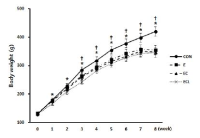
The purpose of this study was to examine the effect of dietary creatine and leucine supplementation on protein synthesis and functional properties of skeletal muscle during 8 weeks of resistance exercise. Thirty two male Sprague-Dawley rat(5 weeks old) were randomly divided into four groups(8 rats per group): sedentary control group(CON), execise group(E), exercise with creatine supplementation group(EC), exercise with creatine, leucine supplementation group(ECL). Exercise groups were trained to climb a ladder with a weight secured to their tails(3day/week). The supplementation was administrated daily through oral gavage. Creatine supplementation was given at 250㎎/㎏/day. Creatine+leucine supplementation was given at 250+250㎎/㎏/day. All exercise groups presented significantly lower epididymal fat mass than CON(p<.05). E presented significantly higher plantaris mass than CON(p<.05). All exercise groups significantly presented higher FHL mass than CON(p<.05) and E presented higher FHL mass than EC, ECL(p<.05). EC, ECL presented significantly lower expression of Akt/PKB protein than CON, E(p<.05). There was no difference in the expression of mTOR protein. The results suggest that the creatine and leucine supplementation does not promote any additional hypertrophic effect on resistance trained skeletal muscle. But, creatine and leucine supplementation might have a potential benefit on skeletal muscle hypertrophy through the activation of protein synthesis.

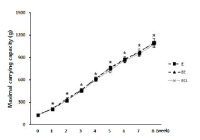



The purpose of this study was to classify high school baseball players as superior or inferior group by Functional Movement Screen(FMS) and to provide basic information for finding great pitcher and improving exercise performance by comparing and analyzing the pitching motion. The results of this study are as follows. The inferior group’s center of mass(COM) moved significant on the left side than superior group at heel contact(HC), ball release(BR), and follow throw(FT)(p<.05). There were no significant difference in linear velocity of shoulder, elbow and wrist between two groups, but inferior groups showed large difference in each joint. The superior group controled rotation of pelvis at HC and showed significant higher knee extension at BR and FT than inferior group(p<.05). The angular velocity of superior group’s throwing arm were higher in acceleration period(p<.05). Taken together based on the results, the players who have higher muscle function showed great pitching motion, so we can conclude that FMS could be useful for evaluating the potential of pitcher.

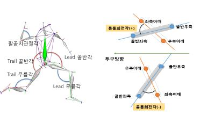
PURPOSE This study aimed to investigate the effects of an 8-week unstable surface Pilates training on physical fitness, abdominal muscle thickness, lumbar isokinetic muscle function, and pain in women aged 30–40 who are living a sedentary lifestyle and experiencing nonspecific low back pain. METHODS The training group (TR, n = 15) performed Pilates using small apparatuses on an unstable surface for 50 min/session, three sessions per week for 8 weeks, whereas the control group (n = 13) maintained their usual living pattern during the same intervention period. RESULTS 1) The body weight, body mass index, percent body fat, and fat mass decreased significantly in the TR, 2) whereas the hand grip strength, trunk extension, sit-andreach, and modified Schober test scores improved significantly. 3) The thickness of the external oblique, internal oblique, and transversus abdominis increased significantly in the TR. 4) Lumbar isokinetic flexor strength per body weight increased significantly in the TR. The endurance and endurance per body weight of the lumbar isokinetic extensor and lumbar isokinetic flexor also significantly increased in the TR. 5) The Korean Oswestry disability index (KODI) and the visual analog scale (VAS) score decreased significantly in the TR. 6) Significant negative correlations were found between the change rates in the KODI and nondominant hand grip strength, external oblique thickness, transversus abdominis thickness, and lumbar isokinetic extensor endurance. A significant negative correlation was found between the change rates in the VAS score and external oblique thickness. CONCLUSIONS The results revealed that the 8-week unstable surface Pilates training was beneficial in improving physical fitness, abdominal muscle thickness, lumbar isokinetic muscle function, disabilityindex, and pain levels in women aged 30–40 years who were having a sedentary lifestyle and experiencing nonspecific low back pain.